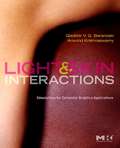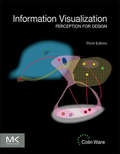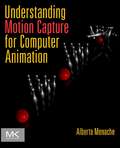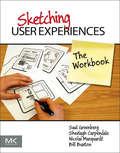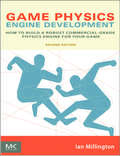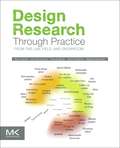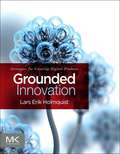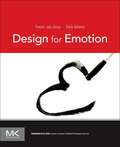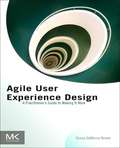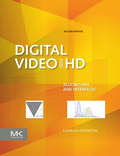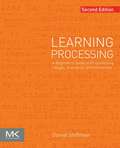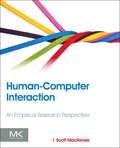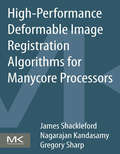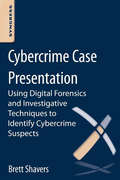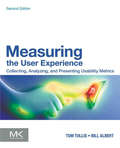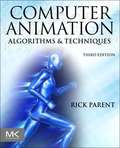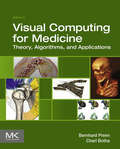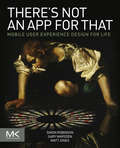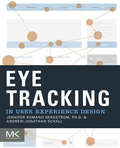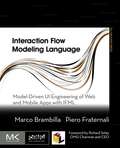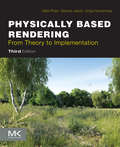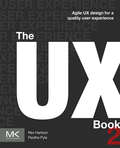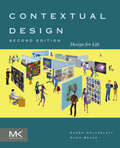- Table View
- List View
Physically Based Rendering: From Theory to Implementation
by Matt Pharr Greg HumphreysPhysically Based Rendering, Second Edition, describes both the mathematical theory behind a modern photorealistic rendering system as well as its practical implementation. A method known as literate programming combines human-readable documentation and source code into a single reference that is specifically designed to aid comprehension. The result is a stunning achievement in graphics education. Through the ideas and software in this book, you will learn to design and employ a full-featured rendering system for creating stunning imagery. This new edition greatly refines its best-selling predecessor by streamlining all obsolete code as well as adding sections on parallel rendering and system design; animating transformations; multispectral rendering; realistic lens systems; blue noise and adaptive sampling patterns and reconstruction; measured BRDFs; and instant global illumination, as well as subsurface and multiple-scattering integrators. These updates reflect the current state-of-the-art technology, and along with the lucid pairing of text and code, ensure the book's leading position as a reference text for those working with images, whether it is for film, video, photography, digital design, visualization, or gaming.The book that won its authors a 2014 Academy Award for Scientific and Technical Achievement from the Academy of Motion Picture Arts and SciencesNew sections on subsurface scattering, Metropolis light transport, precomputed light transport, multispectral rendering, and much moreIncludes a companion site complete with source code for the rendering system described in the book, with support for Windows, OS X, and Linux: visit www.pbrt.orgCode and text are tightly woven together through a unique indexing feature that lists each function, variable, and method on the page that they are first described
Light and Skin Interactions: Simulations for Computer Graphics Applications
by Aravind Krishnaswamy Gladimir V. BaranoskiLight and Skin Interactions immerses you in one of the most fascinating application areas of computer graphics: appearance simulation. The book first illuminates the fundamental biophysical processes that affect skin appearance, and reviews seminal related works aimed at applications in life and health sciences. It then examines four exemplary modeling approaches as well as definitive algorithms that can be used to generate realistic images depicting skin appearance. Despite its wide scope of simulation approaches, the book’s content is presented in a concise manner, focusing on relevant practical aspects. What’s more, these approaches can be successfully applied to a wide range of additional materials, such as eye tissue, hair, and water.Allows you to understand and predict the qualitative and quantitative behavior of complex natural systemsA general background on tissue optics clarifies several confusing conceptual issues, saving you valuable time in the early stages of researchIncludes complete code and data sources for the BioSpec model
Information Visualization: Perception for Design (Interactive Technologies)
by Colin WareMost designers know that yellow text presented against a blue background reads clearly and easily, but how many can explain why, and what really are the best ways to help others and ourselves clearly see key patterns in a bunch of data? When we use software, access a website, or view business or scientific graphics, our understanding is greatly enhanced or impeded by the way the information is presented. This book explores the art and science of why we see objects the way we do. Based on the science of perception and vision, the author presents the key principles at work for a wide range of applications--resulting in visualization of improved clarity, utility, and persuasiveness. The book offers practical guidelines that can be applied by anyone: interaction designers, graphic designers of all kinds (including web designers), data miners, and financial analysts.Complete update of the recognized source in industry, research, and academic for applicable guidance on information visualizingIncludes the latest research and state of the art information on multimedia presentationMore than 160 explicit design guidelines based on vision scienceA new final chapter that explains the process of visual thinking and how visualizations help us to think about problemsPacked with over 400 informative full color illustrations, which are key to understanding of the subject
Understanding Motion Capture for Computer Animation
by Alberto MenacheUnderstanding Motion Capture for Computer Animation discusses the latest technology developments in digital design, film, games, medicine, sports, and security engineering. Motion capture records a live-motion event and translates it into a digital context. It is the technology that converts a live performance into a digital performance. In contrast, performance animation is the actual performance that brings life to the character, even without using technology. If motion capture is the collection of data that represents motion, performance animation is the character that a performer represents. The book offers extensive information about motion capture. It includes state-of-the-art technology, methodology, and developments in the current motion-capture industry. In particular, the different ways to capture motions are discussed, including using cameras or electromagnetic fields in tracking a group of sensors. This book will be useful for students taking a course about digital filming, as well as for anyone who is interested in this topic. Completely revised to include almost 40% new content with emphasis on RF and Facial Motion Capture SystemsDescribes all the mathematical principles associated with motion capture and 3D character mechanicsHelps you budget by explaining the costs associated with individualized motion capture projects
Sketching User Experiences: The Workbook
by Sheelagh Carpendale Bill Buxton Saul Greenberg Nicolai MarquardtSketching Working Experience: The Workbook provides information about the step-by-step process of the different sketching techniques. It offers methods called design thinking, as a way to think as a user, and sketching, a way to think as a designer. User-experience designers are designers who sketch based on their actions, interactions, and experiences. The book discusses the differences between the normal ways to sketch and sketching used by user-experience designers. It also describes some motivation on why a person should sketch and introduces the sketchbook. The book reviews the different sketching methods and the modules that contain a particular sketching method. It also explains how the sketching methods are used. Readers who are interested in learning, understanding, practicing, and teaching experience design, information design, interface design, and information architecture will find this book relevant.Features standalone modules detailing methods and exercises for practitioners who want to learn and develop their sketching skills Extremely practical, with illustrated examples detailing all steps on how to do a method Excellent for individual learning, for classrooms, and for a team that wants to develop a culture of design practice Perfect complement to Buxton’s Sketching User Experience or any UX text Author-maintained companion website at http://grouplab.cpsc.ucalgary.ca/sketchbook/
Game Physics Engine Development: How to Build a Robust Commercial-Grade Physics Engine for your Game
by Ian MillingtonPhysics is really important to game programmers who need to know how to add physical realism to their games. They need to take into account the laws of physics when creating a simulation or game engine, particularly in 3D computer graphics, for the purpose of making the effects appear more real to the observer or player.The game engine ne
Design Research Through Practice: From the Lab, Field, and Showroom
by Thomas Binder Ilpo Koskinen Johan Redstrom John Zimmerman Stephan WensveenDesign Research Through Practice: From the Lab, Field, and Showroom focuses on one type of contemporary design research known as constructive design research. It looks at three approaches to constructive design research: Lab, Field, and Showroom. The book shows how theory, research practice, and the social environment create commonalities between these approaches. It illustrates how one can successfully integrate design and research based on work carried out in industrial design and interaction design. The book begins with an overview of the rise of constructive design research, as well as constructive research programs and methodologies. It then describes the logic of studying design in the laboratory, design ethnography and field work, and the origins of the Showroom and its foundation on art and design rather than on science or the social sciences. It also discusses the theoretical background of constructive design research, along with modeling and prototyping of design items. Finally, it considers recent work in Lab that focuses on action and the body instead of thinking and knowing. Many kinds of designers and people interested in design will find this book extremely helpful. Gathers design research experts from traditional lab science, social science, art, industrial design, UX and HCI to lend tested practices and how they can be used in a variety of design projectsProvides a multidisciplinary story of the whole design process, with proven and teachable techniques that can solve both academic and practical problemsPresents key examples illustrating how research is applied and vignettes summarizing the key how-to details of specific projects
Grounded Innovation: Strategies for Creating Digital Products
by Lars Erik HolmquistGrounded Innovation: Strategies for Creating Digital Products focuses on the innovation processes and technical properties of digital products. Drawing on case studies, the book looks at systematic ways to ground innovation in both technology and human needs, and it explores how digital products have become integrated in the real world. It provides guidelines to innovation in a new technical environment, including prototyping and testing, within the cultural or financial parameters of a business. The book is divided into two parts. Part 1 discusses the history and the basic properties of digital products; the different approaches to innovation; the concept of grounded innovation; and concepts and processes that are important for creating successful innovations such as inquiry, invention, and prototyping. Part 2 demonstrates how the basic properties of digital products can be used as raw material for new innovations, including interaction, networking, sensing, and proactivity. There is also a discussion on recent technology, such as rapid prototyping and mobile mash-ups. A wide variety of examples show how novel technical and conceptual innovations became commercial breakthroughs. Grounded Innovation is ideal for product designers, interaction designers, and design-oriented engineers. It will also be a valuable resource for anyone interested in understanding how digital products are created and in a general approach to information technology. Wide variety of examples show how novel technical and conceptual innovations became commercial breakthroughsProvides guidelines to innovation in a new technical environment including prototyping and testingDiscusses how to innovate within the cultural or financial parameters of a business
Design for Emotion
by Trevor van Gorp Edie AdamsDesign for Emotion introduces you to the why, what, when, where and how of designing for emotion. Improve user connection, satisfaction and loyalty by incorporating emotion and personality into your design process. The conscious and unconscious origins of emotions are explained, while real-world examples show how the design you create affects the emotions of your users. This isn’t just another design theory book – it’s imminently practical. Design for Emotion introduces the A.C.T. Model (Attract/Converse/Transact) a tool for helping designers create designs that intentionally trigger emotional responses. This book offers a way to harness emotions for improving the design of products, interfaces and applications while also enhancing learning and information processing. Design for Emotion will help your designs grab attention and communicate your message more powerfully, to more people. Explains the relationship between emotions and product personalitiesDetails the most important dimensions of a product's personalityExamines models for understanding users' relationships with productsExplores how to intentionally design product personalities Provides extensive examples from the worlds of product, web and application designIncludes a simple and effective model for creating more emotional designs
Agile User Experience Design: A Practitioner’s Guide to Making It Work
by Diana BrownBeing able to fit design into the Agile software development processes is an important skill in today’s market. There are many ways for a UX team to succeed (and fail) at being Agile. This book provides you with the tools you need to determine what Agile UX means for you. It includes practical examples and case studies, as well as real-life factors to consider while navigating the Agile UX waters. You’ll learn about what contributes to your team’s success, and which factors to consider when determining the best path for getting there. After reading this book, you’ll have the knowledge to improve your software and product development with Agile processes quickly and easily. Includes hands on, real-world examples to illustrate the successes and common pitfalls of Agile UXIntroduces practical techniques that can be used on your next projectDetails how to incorporate user experience design into your company's agile software/product process
Digital Video and HD: Algorithms and Interfaces (The Morgan Kaufmann Series in Computer Graphics)
by Charles PoyntonDigital Video and HD: Algorithms and Interfaces provides a one-stop shop for the theory and engineering of digital video systems. Equally accessible to video engineers and those working in computer graphics, Charles Poynton’s revision to his classic text covers emergent compression systems, including H.264 and VP8/WebM, and augments detailed information on JPEG, DVC, and MPEG-2 systems. This edition also introduces the technical aspects of file-based workflows and outlines the emerging domain of metadata, placing it in the context of digital video processing. Basic concepts of digitization, sampling, quantization, gamma, and filteringPrinciples of color science as applied to image capture and displayScanning and coding of SDTV and HDTVVideo color coding: luma, chroma (4:2:2 component video, 4fSC composite video)Analog NTSC and PALStudio systems and interfacesCompression technology, including M-JPEG and MPEG-2Broadcast standards and consumer video equipment
Learning Processing: A Beginner's Guide to Programming Images, Animation, and Interaction (The Morgan Kaufmann Series in Computer Graphics)
by Daniel ShiffmanLearning Processing, Second Edition, is a friendly start-up guide to Processing, a free, open-source alternative to expensive software and daunting programming languages. Requiring no previous experience, this book is for the true programming beginner. It teaches the basic building blocks of programming needed to create cutting-edge graphics applications including interactive art, live video processing, and data visualization. Step-by-step examples, thorough explanations, hands-on exercises, and sample code, supports your learning curve. A unique lab-style manual, the book gives graphic and web designers, artists, and illustrators of all stripes a jumpstart on working with the Processing programming environment by providing instruction on the basic principles of the language, followed by careful explanations of select advanced techniques. The book has been developed with a supportive learning experience at its core. From algorithms and data mining to rendering and debugging, it teaches object-oriented programming from the ground up within the fascinating context of interactive visual media. This book is ideal for graphic designers and visual artists without programming background who want to learn programming. It will also appeal to students taking college and graduate courses in interactive media or visual computing, and for self-study.A friendly start-up guide to Processing, a free, open-source alternative to expensive software and daunting programming languages No previous experience required—this book is for the true programming beginner!Step-by-step examples, thorough explanations, hands-on exercises, and sample code supports your learning curve
Human-Computer Interaction: An Empirical Research Perspective
by I. Scott MacKenzieHuman-Computer Interaction: An Empirical Research Perspective is the definitive guide to empirical research in HCI. The book begins with foundational topics including historical context, the human factor, interaction elements, and the fundamentals of science and research. From there, you'll progress to learning about the methods for conducting an experiment to evaluate a new computer interface or interaction technique. There are detailed discussions and how-to analyses on models of interaction, focusing on descriptive models and predictive models. Writing and publishing a research paper is explored with helpful tips for success. Throughout the book, you'll find hands-on exercises, checklists, and real-world examples. This is your must-have, comprehensive guide to empirical and experimental research in HCI—an essential addition to your HCI library. Master empirical and experimental research with this comprehensive, A-to-Z guide in a concise, hands-on referenceDiscover the practical and theoretical ins-and-outs of user studiesFind exercises, takeaway points, and case studies throughout
High Performance Deformable Image Registration Algorithms for Manycore Processors
by James Shackleford Nagarajan Kandasamy Gregory SharpHigh Performance Deformable Image Registration Algorithms for Manycore Processors develops highly data-parallel image registration algorithms suitable for use on modern multi-core architectures, including graphics processing units (GPUs). Focusing on deformable registration, we show how to develop data-parallel versions of the registration algorithm suitable for execution on the GPU. Image registration is the process of aligning two or more images into a common coordinate frame and is a fundamental step to be able to compare or fuse data obtained from different sensor measurements. Extracting useful information from 2D/3D data is essential to realizing key technologies underlying our daily lives. Examples include autonomous vehicles and humanoid robots that can recognize and manipulate objects in cluttered environments using stereo vision and laser sensing and medical imaging to localize and diagnose tumors in internal organs using data captured by CT/MRI scans.Demonstrates how to redesign widely used image registration algorithms so as to best expose the underlying parallelism available in these algorithmsShows how to pose and implement the parallel versions of the algorithms within the single instruction, multiple data (SIMD) model supported by GPUsProvides Programming "tricks" that can help readers develop other image processing algorithms, including registration algorithms for the GPU
Cybercrime Case Presentation: An Excerpt from Placing The Suspect Behind The Keyboard
by Brett ShaversCybercrime Case Presentation is a "first look" excerpt from Brett Shavers' new Syngress book, Placing the Suspect Behind the Keyboard. Case presentation requires the skills of a good forensic examiner and great public speaker in order to convey enough information to an audience for the audience to place the suspect behind the keyboard. Using a variety of visual aids, demonstrative methods, and analogies, investigators can effectively create an environment where the audience fully understands complex technical information and activity in a chronological fashion, as if they observed the case as it happened.
Measuring the User Experience: Collecting, Analyzing, and Presenting Usability Metrics (Interactive Technologies)
by William Albert Thomas TullisMeasuring the User Experience was the first book that focused on how to quantify the user experience. Now in the second edition, the authors include new material on how recent technologies have made it easier and more effective to collect a broader range of data about the user experience. As more UX and web professionals need to justify their design decisions with solid, reliable data, Measuring the User Experience provides the quantitative analysis training that these professionals need. The second edition presents new metrics such as emotional engagement, personas, keystroke analysis, and net promoter score. It also examines how new technologies coming from neuro-marketing and online market research can refine user experience measurement, helping usability and user experience practitioners make business cases to stakeholders. The book also contains new research and updated examples, including tips on writing online survey questions, six new case studies, and examples using the most recent version of Excel.Learn which metrics to select for every case, including behavioral, physiological, emotional, aesthetic, gestural, verbal, and physical, as well as more specialized metrics such as eye-tracking and clickstream dataFind a vendor-neutral examination of how to measure the user experience with web sites, digital products, and virtually any other type of product or systemDiscover in-depth global case studies showing how organizations have successfully used metrics and the information they revealedCompanion site, www.measuringux.com, includes articles, tools, spreadsheets, presentations, and other resources to help you effectively measure the user experience
Computer Animation: Algorithms and Techniques (The\morgan Kaufmann Series In Computer Graphics Ser.)
by Rick ParentDriven by demand from the entertainment industry for better and more realistic animation, technology continues to evolve and improve. The algorithms and techniques behind this technology are the foundation of this comprehensive book, which is written to teach you the fundamentals of animation programming. In this third edition, the most current techniques are covered along with the theory and high-level computation that have earned the book a reputation as the best technically-oriented animation resource. Key topics such as fluids, hair, and crowd animation have been expanded, and extensive new coverage of clothes and cloth has been added. New material on simulation provides a more diverse look at this important area and more example animations and chapter projects and exercises are included. Additionally, spline coverage has been expanded and new video compression and formats (e.g., iTunes) are covered.Includes companion site with contemporary animation examples drawn from research and entertainment, sample animations, and example codeDescribes the key mathematical and algorithmic foundations of animation that provide you with a deep understanding and control of techniqueExpanded and new coverage of key topics including: fluids and clouds, cloth and clothes, hair, and crowd animationExplains the algorithms used for path following, hierarchical kinematic modelling, rigid body dynamics, flocking behaviour, particle systems, collision detection, and more
Visual Computing for Medicine: Theory, Algorithms, and Applications (The Morgan Kaufmann Series in Computer Graphics)
by Bernhard Preim Charl P BothaVisual Computing for Medicine, Second Edition, offers cutting-edge visualization techniques and their applications in medical diagnosis, education, and treatment. The book includes algorithms, applications, and ideas on achieving reliability of results and clinical evaluation of the techniques covered. Preim and Botha illustrate visualization techniques from research, but also cover the information required to solve practical clinical problems. They base the book on several years of combined teaching and research experience. This new edition includes six new chapters on treatment planning, guidance and training; an updated appendix on software support for visual computing for medicine; and a new global structure that better classifies and explains the major lines of work in the field. Complete guide to visual computing in medicine, fully revamped and updated with new developments in the fieldIllustrated in full colorIncludes a companion website offering additional content for professors, source code, algorithms, tutorials, videos, exercises, lessons, and more
There's Not an App for That: Mobile User Experience Design for Life
by Simon Robinson Matt Jones Gary MarsdenThere’s Not an App for That will make your work stand out from the crowd. It walks you through mobile experiences, and teaches you to evaluate current UX approaches, enabling you to think outside of the screen and beyond the conventional. You’ll review diverse aspects of mobile UX: the screens, the experience, how apps are used, and why they’re used. You’ll find special sections on "challenging your approach", as well as a series of questions you can use to critique and evaluate your own designs. Whether the authors are discussing real-world products in conjunction with suggested improvements, showcasing how existing technologies can be put together in unconventional ways, or even evaluating "far out" mobile experiences of the future, you’ll find plenty of practical pointers and action items to help you in your day-to-day work.Provides you with new and innovative ways to think about mobile designIncludes future mobile interfaces and interactions, complete with real-world, applied information that teaches you how today’s mobile services can be improvedIllustrates themes from existing systems and apps to show clear paths of thought and development, enabling you to better design for the future
Eye Tracking in User Experience Design
by Andrew Schall Jennifer Romano BergstromEye Tracking for User Experience Design explores the many applications of eye tracking to better understand how users view and interact with technology. Ten leading experts in eye tracking discuss how they have taken advantage of this new technology to understand, design, and evaluate user experience. Real-world stories are included from these experts who have used eye tracking during the design and development of products ranging from information websites to immersive games. They also explore recent advances in the technology which tracks how users interact with mobile devices, large-screen displays and video game consoles. Methods for combining eye tracking with other research techniques for a more holistic understanding of the user experience are discussed. This is an invaluable resource to those who want to learn how eye tracking can be used to better understand and design for their users.Includes highly relevant examples and information for those who perform user research and design interactive experiencesWritten by numerous experts in user experience and eye trackingHighly relevant to anyone interested in eye tracking & UX designFeatures contemporary eye tracking research emphasizing the latest uses of eye tracking technology in the user experience industry
Interaction Flow Modeling Language: Model-Driven UI Engineering of Web and Mobile Apps with IFML (The MK/OMG Press)
by Marco Brambilla Piero FraternaliInteraction Flow Modeling Language describes how to apply model-driven techniques to the problem of designing the front end of software applications, i.e., the user interaction. The book introduces the reader to the novel OMG standard Interaction Flow Modeling Language (IFML). Authors Marco Brambilla and Piero Fraternali are authors of the IFML standard and wrote this book to explain the main concepts of the language. They effectively illustrate how IFML can be applied in practice to the specification and implementation of complex web and mobile applications, featuring rich interactive interfaces, both browser based and native, client side components and widgets, and connections to data sources, business logic components and services. Interaction Flow Modeling Language provides you with unique insight into the benefits of engineering web and mobile applications with an agile model driven approach. Concepts are explained through intuitive examples, drawn from real-world applications. The authors accompany you in the voyage from visual specifications of requirements to design and code production. The book distills more than twenty years of practice and provides a mix of methodological principles and concrete and immediately applicable techniques.Learn OMG’s new IFML standard from the authors of the standard with this approachable referenceIntroduces IFML concepts step-by-step, with many practical examples and an end-to-end case exampleShows how to integrate IFML with other OMG standards including UML, BPMN, CWM, SoaML and SysMLDiscusses how to map models into code for a variety of web and mobile platforms and includes many useful interface modeling patterns and best practices
Firearm and Toolmark Examination and Identification (Advanced Forensic Science Ser.)
by Max M. HouckThe Advanced Forensic Science Series grew out of the recommendations from the 2009 NAS Report: "Strengthening Forensic Science: A Path Forward." This volume, Firearm and Toolmark Examination and Identification, will serve as a graduate-level text for those studying and teaching firearm and toolmark examination and identification. It will also prove an excellent reference for forensic practitioner's libraries or use in their casework. Coverage includes a wide variety of tools and toolmarks, analysis of gunshots, ammunition, gunshot wounds and professional issues they may encounter.
Physically Based Rendering: From Theory to Implementation
by Matt Pharr Wenzel Jakob Greg HumphreysPhysically Based Rendering: From Theory to Implementation, Third Edition, describes both the mathematical theory behind a modern photorealistic rendering system and its practical implementation. Through a method known as 'literate programming', the authors combine human-readable documentation and source code into a single reference that is specifically designed to aid comprehension. The result is a stunning achievement in graphics education. Through the ideas and software in this book, users will learn to design and employ a fully-featured rendering system for creating stunning imagery. This completely updated and revised edition includes new coverage on ray-tracing hair and curves primitives, numerical precision issues with ray tracing, LBVHs, realistic camera models, the measurement equation, and much more. It is a must-have, full color resource on physically-based rendering.Presents up-to-date revisions of the seminal reference on rendering, including new sections on bidirectional path tracing, numerical robustness issues in ray tracing, realistic camera models, and subsurface scatteringProvides the source code for a complete rendering system allowing readers to get up and running fastIncludes a unique indexing feature, literate programming, that lists the locations of each function, variable, and method on the page where they are first describedServes as an essential resource on physically-based rendering
The UX Book: Agile UX Design for a Quality User Experience
by Rex Hartson Pardha S. PylaThe discipline of user experience (UX) design has matured into a confident practice and this edition reflects, and in some areas accelerates, that evolution. Technically this is the second edition of The UX Book, but so much of it is new, it is more like a sequel. One of the major positive trends in UX is the continued emphasis on design—a kind of design that highlights the designer’s creative skills and insights and embodies a synthesis of technology with usability, usefulness, aesthetics, and meaningfulness to the user. In this edition a new conceptual top-down design framework is introduced to help readers with this evolution. This entire edition is oriented toward an agile UX lifecycle process, explained in the funnel model of agile UX, as a better match to the now de facto standard agile approach to software engineering. To reflect these trends, even the subtitle of the book is changed to “Agile UX design for a quality user experience". Designed as a how-to-do-it handbook and field guide for UX professionals and a textbook for aspiring students, the book is accompanied by in-class exercises and team projects. The approach is practical rather than formal or theoretical. The primary goal is still to imbue an understanding of what a good user experience is and how to achieve it. To better serve this, processes, methods, and techniques are introduced early to establish process-related concepts as context for discussion in later chapters. Winner of a 2020 Textbook Excellence Award (College) (Texty) from the Textbook and Academic Authors AssociationA comprehensive textbook for UX/HCI/Interaction Design students readymade for the classroom, complete with instructors’ manual, dedicated web site, sample syllabus, examples, exercises, and lecture slidesFeatures HCI theory, process, practice, and a host of real world stories and contributions from industry luminaries to prepare students for working in the fieldThe only HCI textbook to cover agile methodology, design approaches, and a full, modern suite of classroom material (stemming from tried and tested classroom use by the authors)
Contextual Design: Design for Life (Interactive Technologies)
by Karen Holtzblatt Hugh BeyerContextual Design: Design for Life, Second Edition, describes the core techniques needed to deliberately produce a compelling user experience. Contextual design was first invented in 1988 to drive a deep understanding of the user into the design process. It has been used in a wide variety of industries and taught in universities all over the world. Until now, the basic CD approach has needed little revision, but with the wide adoption of handheld devices, especially smartphones, the way technology is integrated into people’s lives has fundamentally changed. Contextual Design V2.0 introduces both the classic CD techniques and the new techniques needed to "design for life", fulfilling core human motives while supporting activities. This completely updated and revised edition is written in a clear, informal style without excessive jargon, and is the must-have book for any UX Design library. Users will find coverage of mobile devices and consumer and business products, all illustrated with new examples, case studies, and discussions on how to use CD with the agile development and other project requirements methods.Provides tactics on how to gather detailed data on how people live, work, and use productsHelps develop a coherent picture of a whole user population Presents tactics on how to use the seven "Cool Concepts" to support core human motives and generate new product concepts guided by user data, ideation techniques, and principles key to producing a compelling user experienceExplains how to structure the system and user interface to best support the user across place, time, and platform

